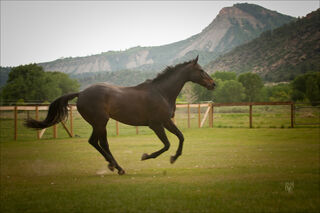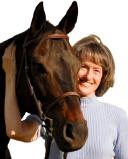Trust
Why Do Horses and Humans Need to Communicate?
Horses and handlers require mutual real-time communication to perform well.
Posted June 29, 2021 Reviewed by Devon Frye
Key points
- Horse sports are widely varied, but all require horse-human communication.
- Horse-human messaging at its best is imperceptible, so most people don't know it occurs.
- Horses and riders form teams on equal footing; both parties are essential.
- Horse sports are unique in demanding such close interaction between prey and predator brains.

You’ve probably seen a horse run a race, muscles rippling in the sun as his legs reach forward by impossible distances to gather the earth toward him. But what else can horses do, and why does equine performance require prey and predator brains to communicate with each other?
Horse sports include many different activities: polo, dressage, cutting, jumping, fox hunting, driving, draft pulling, trail riding, vaulting, rodeo, roping, ranch work, theatrical entertainment… just to name a few. Not to mention endurance, speed, harness, barrel, and steeplechase racing. (To see these sports in action, search YouTube for any of these terms, click on a brief video, and admire.)
The vast majority of a horse’s talent develops through daily interaction with human trainers. Take jumping, for instance. It’s true that horses have the native ability to clear hurdles, just like people do. But owning legs that can fold up tight and sail through the air is very different from completing the actual task. With years of training, exercise, and practice, I could probably learn to vault over a hurdle in a sluggish foot race. Well, maybe. But I certainly can’t do it on a first try in my backyard. Neither can the horse.
Let’s consider a thought experiment: Imagine a solid wall seven feet high and two feet wide. A horse and rider are galloping toward it with the intent to jump. The horse can’t see around, behind, or over that wall—he is a prey animal leaping into blind oblivion. If successful, the team will clear the top of this enormous obstacle and land in one piece on the opposite side. If not, they will crash.
Crashes at this height often result in injury, sometimes death, to horse or rider. So the stakes of horse-human communication here are, shall we say, HIGH. (Google a video clip of “Puissance wall” if you dare, and you’ll see what I mean.) The horse attempts treacherous feats in all sorts of disciplines only because he has been trained to understand and trust the messages his rider is sending.
And what would those messages be? Well, in our example, a jumper rider has to keep the horse calm and confident in the face of a very frightening task. She has to rate his canter stride by stride to achieve the perfect pace, length, and impulsion to clear such a formidable object.
She has to set up his approach from 75 feet away so that he can leave the ground at precisely the right distance from that wall—a foot too close, and he’ll run into it with his front legs; a foot too far away, and his body will be on a downward arc before his hind legs clear the top. She has to maintain the horse’s total focus on her cues. If he shies from a child waving a balloon in the stands, this jump will turn into a train wreck.
It’s not just the horse that our rider has to control. She also has to carry and balance her own body in exact moving equilibrium with his. To do this, she reaches with her back, shoulders, arms, even her fingertips, to follow his long neck over the top. This way, she avoids touching the horse’s mouth, which would send a message saying, “Whoops, never mind, let’s not jump this after all.” It’s way too late for that.
She pushes most of her weight down into her lower legs and heels to prevent being jumped off like a cork. Remember, she’s perched on thirteen or fourteen hundred pounds of solid bone and muscle, a living animal cracking his back by suddenly powering seven feet upward from underneath his rider! An untrained passenger would fly straight up in the air for a long way before beginning her journey back down to earth.
Almost no one realizes that riders communicate so closely with their mounts. We imagine instead that she’s simply clinging for dear life up there. Good riding cues are imperceptible—the highly sensitive horse feels the rider’s leg, seat, and hand pressures, and notices tiny shifts of balance and weight distribution. But onlookers can’t see any of that. That’s why they assume that equine performance is a simple matter of the horse’s innate talent and the rider’s ability to hang on.
What about the horse? Is he communicating with his rider during the performance? You bet he is, every single moment! As this pair gallops toward that huge wall, the horse is using his body to ask the rider a hundred questions: "Are we jumping over that thing? Are you serious? What’s the right speed? How can I get my legs into the perfect position to take off? Will you keep your balance without changing your weight distribution on my back? What about that balloon? Are you scared? Uh-oh, this thing is even bigger than I thought—should we change plans?"
Of course, horses don’t ask in words the way we do, but their bodies are sending us exactly those messages. And we riders answer back using our bodies: "Yes sir, I AM serious. Shorten your stride six inches here so you can take off in the right spot. Stay straight. Aim for the center. Drop low right now, so you can spring upward. Forget the balloon. Push, push, push with those hind legs. Easy now…"
The extreme difficulty of jumping a seven-foot wall means that most trained horse-and-human teams will fail. What allows the few to succeed? Many factors—strength, agility, courage, timing, years of daily training, and more. But the biggest factor for success is mutual communication between the horse’s prey brain and the human’s predator brain.
We horse folks communicate closely with our four-legged team members not only for pleasure and trust, but also to stay alive while performing bold athletic feats. How do we send and receive real-time messages back and forth so fast? Stick with me, we’re gettin’ to that.




